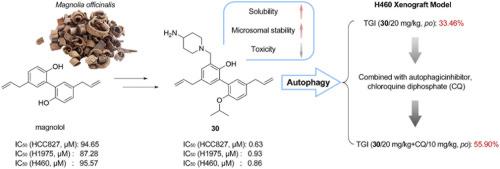European Journal of Medicinal Chemistry ( IF 6.0 ) Pub Date : 2020-10-10 , DOI: 10.1016/j.ejmech.2020.112922
Min Zhao 1 , Yun-Hua Zheng 1 , Qi-Yuan Zhao 1 , Wei Zheng 1 , Jian-Hong Yang 1 , He-Ying Pei 1 , Ling Liu 2 , Kong-Jun Liu 1 , Lin-Lin Xue 1 , De-Xin Deng 1 , Lun Wang 1 , Xu Ma 1 , Su-Hong Fu 1 , Ai-Hua Peng 1 , Ming-Hai Tang 1 , Yun-Zi Luo 1 , Hao-Yu Ye 1 , Li-Juan Chen 3

|
Magnolol and honokiol are the two major active ingredients with similar structure and anticancer activity from traditional Chinese medicine Magnolia officinalis, and honokiol is now in a phase I clinical trial (CTR20170822) for advanced non-small cell lung cancer (NSCLC). In search of potent lead compounds with better activity, our previous study has demonstrated that magnolol derivative C2, 3-(4-aminopiperidin-1-yl)methyl magnolol, has better activity than honokiol. Here, based on the core of 3-(4-aminopiperidin-1-yl)methyl magnolol, we synthesized fifty-one magnolol derivatives. Among them, compound 30 exhibited the most potent antiproliferative activities on H460, HCC827, H1975 cell lines with the IC50 values of 0.63–0.93 μM, which were approximately 10- and 100-fold more potent than those of C2 and magnolol, respectively. Besides, oral administration of 30 and C2 on an H460 xenograft model also demonstrated that 30 has better activity than C2. Mechanism study revealed that 30 induced G0/G1 phase cell cycle arrest, apoptosis and autophagy in cancer cells. Moreover, blocking autophagy by the autophagic inhibitor enhanced the anticancer activity of 30 in vitro and in vivo, suggesting autophagy played a cytoprotective role on 30-induced cancer cell death. Taken together, our study implied that compound 30 combined with autophagic inhibitor could be another choice for NSCLC treatment in further investigation.
中文翻译:

3-(4-氨基哌啶-1-基)甲基厚朴酚支架新化合物的合成与评价作为靶向自噬治疗非小细胞肺癌的抗癌药物
厚朴酚和和厚朴酚是中药厚朴中结构和抗癌活性相似的两种主要活性成分,和厚朴酚目前正处于治疗晚期非小细胞肺癌(NSCLC)的I期临床试验(CTR20170822)中。为了寻找具有更好活性的有效先导化合物,我们之前的研究表明,厚朴酚衍生物C2 3-(4-aminopiperidin-1-yl)methyl magnolol 比和厚朴酚具有更好的活性。在此,我们以3-(4-氨基哌啶-1-基)甲基厚朴酚为核心,合成了51种厚朴酚衍生物。其中,化合物30对H460、HCC827、H1975细胞系表现出最有效的抗增殖活性,IC 50值为0.63-0.93 μM,分别比C2和厚朴酚强约10倍和100倍。此外,在H460异种移植模型上口服30和C2也表明30比C2具有更好的活性。机制研究表明, 30诱导癌细胞 G0/G1 期细胞周期停滞、细胞凋亡和自噬。此外,通过自噬抑制剂阻断自噬增强了30的体外和体内抗癌活性,表明自噬在30诱导的癌细胞死亡中发挥了细胞保护作用。综上所述,我们的研究表明,化合物30联合自噬抑制剂可能成为进一步研究中 NSCLC 治疗的另一种选择。

































 京公网安备 11010802027423号
京公网安备 11010802027423号